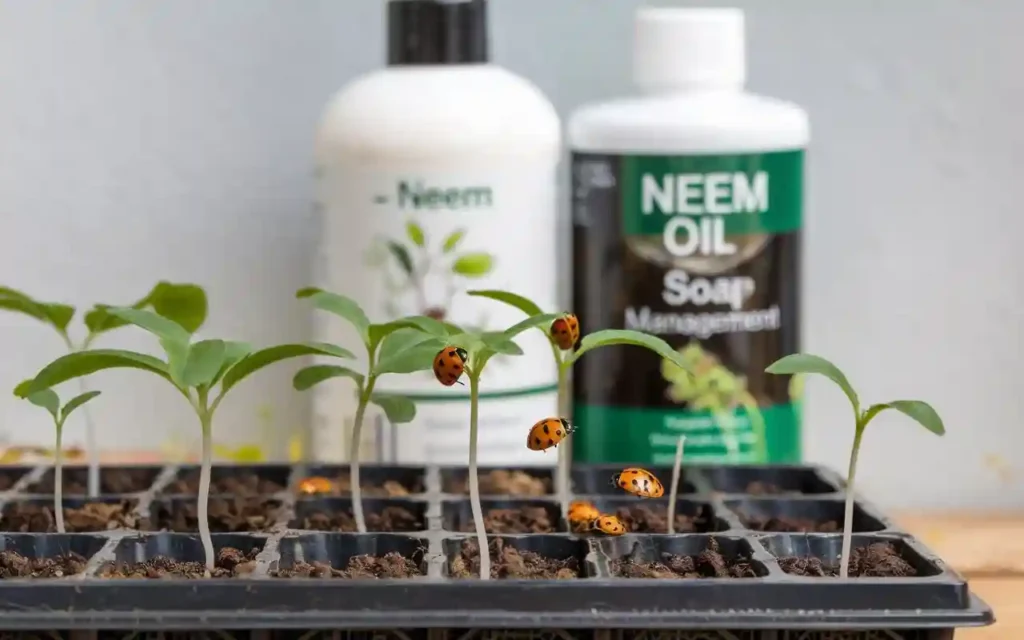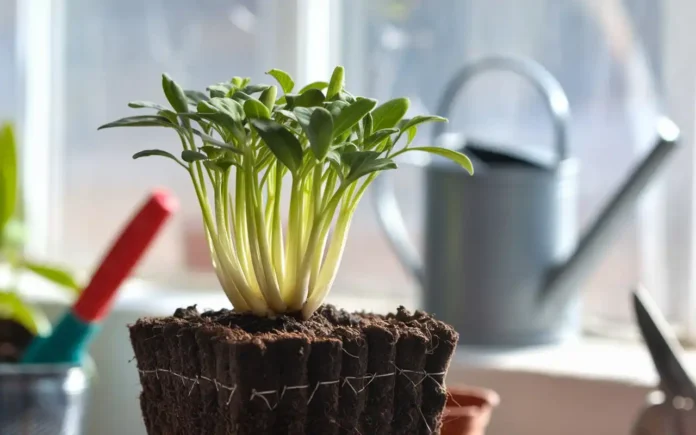Healthy 1 Week Old Seedling: Comprehensive Guide
1. Introduction to Healthy 1 Week Old Seedlings
A healthy 1 week old seedling is the cornerstone of a successful gardening journey. Ensuring that your seedlings are robust and thriving during their initial week sets the stage for strong growth and bountiful yields. This comprehensive guide will walk you through the essential practices needed to maintain healthy 1 week old seedlings, covering everything from lighting and watering to soil health and pest control.
Understanding the specific needs of your seedlings during their first week is crucial. This period is a critical window where proper care can prevent common issues and promote vigorous growth. Whether you’re a seasoned gardener or a novice, mastering the art of nurturing healthy 1 week old seedlings will enhance your gardening success.
2. Optimal Lighting Conditions for Healthy 1 Week Old Seedlings

Lighting plays a pivotal role in fostering a healthy 1 week old seedling. Adequate light ensures photosynthesis, which is vital for the seedling’s growth and development. Without sufficient light, seedlings can become leggy and weak, struggling to establish themselves.
Natural vs. Artificial Lighting
Choosing between natural sunlight and artificial lighting can significantly impact the health of your seedlings. Here’s a detailed comparison:
| Aspect | Natural Sunlight | Artificial Lighting |
|---|---|---|
| Consistency | Variable due to weather and time of day | Controlled and consistent |
| Intensity | High, may require shading during peak hours | Adjustable based on needs |
| Cost | Free | Initial investment and ongoing energy costs |
| Flexibility | Limited to outdoor conditions | Can be used indoors regardless of outdoor weather |
Best Practices for Lighting
- Ensure seedlings receive 12-16 hours of light daily.
- Use grow lights that mimic natural sunlight spectra.
- Position lights 2-4 inches above seedlings and adjust as they grow.
- Rotate seedlings regularly to promote even growth.
- Monitor light intensity to prevent overheating or insufficient lighting.
Maintaining optimal lighting conditions is essential for a healthy 1 week old seedling. Insufficient light can lead to elongated stems and weak structures, while excessive light may cause heat stress and dehydration. Balancing light exposure ensures that your seedlings develop strong, healthy stems and vibrant foliage.
3. Proper Watering Techniques for Healthy 1 Week Old Seedlings

Watering is a critical aspect of nurturing a healthy 1 week old seedling. Proper hydration supports root development and prevents common issues like damping-off, a fungal disease that can devastate young seedlings.
Watering Frequency
Seedlings typically require consistent moisture, but overwatering can be just as harmful as under-watering. Aim to keep the soil evenly moist but not waterlogged. A good rule of thumb is to water when the top of the soil feels slightly dry to the touch.
Best Watering Practices
- Bottom Watering: Place seedling trays in a shallow water bath, allowing the soil to absorb moisture from the bottom up. This prevents soil from becoming overly saturated on the surface.
- Top Watering: Use a gentle spray bottle to mist the soil surface, ensuring even distribution without dislodging seeds.
- Consistent Schedule: Establish a regular watering routine to maintain consistent soil moisture levels.
- Avoid Overhead Watering: Excess water on the foliage can promote fungal diseases.
By adhering to these watering techniques, you ensure that your seedlings remain healthy 1 week old seedlings with strong roots and robust growth. Proper watering not only supports immediate growth but also establishes a solid foundation for future development.
4. Soil Health and Composition for Healthy 1 Week Old Seedlings

The quality of soil is fundamental for a healthy 1 week old seedling. Proper soil provides the necessary nutrients and supports root development, laying the groundwork for vigorous plant growth.
Choosing the Right Soil
Select a well-draining, sterile seed-starting mix. Avoid heavy garden soils that can compact and hinder root growth. A good seedling soil mix typically contains a combination of peat moss or coco coir, perlite or vermiculite, and a small amount of compost or organic matter.
Soil Amendments
- Perlite: Enhances drainage and aeration, preventing soil compaction.
- Vermiculite: Improves moisture retention without making the soil waterlogged.
- Compost: Adds organic matter and nutrients, promoting healthy root growth.
- Sand: Increases soil drainage and prevents clumping.
Using the right soil mix ensures that your healthy 1 week old seedlings have a strong foundation for growth. Good soil structure promotes healthy root systems, improves nutrient uptake, and prevents diseases that can be exacerbated by poor soil conditions.
5. Nutrient Management for Healthy 1 Week Old Seedlings

Proper nutrient management is essential for a healthy 1 week old seedling. While seedlings don’t require heavy fertilization, providing essential nutrients supports their initial growth stages and prevents deficiencies.
Fertilizing Seedlings
Use a diluted, balanced fertilizer to avoid over-fertilizing young seedlings. A common recommendation is to use a quarter-strength solution of a balanced (e.g., 10-10-10) fertilizer. Over-fertilization can lead to nutrient burn, which damages delicate seedlings.
Organic vs. Synthetic Fertilizers
- Organic Fertilizers: Derived from natural sources such as compost, fish emulsion, and bone meal. They improve soil structure and promote beneficial microbial activity.
- Synthetic Fertilizers: Manufactured chemically to provide precise nutrient ratios. They offer immediate nutrient availability but do not enhance soil health.
Appropriate nutrient management ensures that your healthy 1 week old seedlings develop strong stems and leaves. Regularly monitoring nutrient levels and adjusting fertilizer applications can prevent deficiencies and promote balanced growth.
6. Managing Temperature and Humidity for Healthy 1 Week Old Seedlings
Maintaining optimal temperature and humidity levels is crucial for a healthy 1 week old seedling. These factors influence seedling metabolism, growth rates, and overall health.
Ideal Temperature Range
Seedlings generally thrive in temperatures between 65-75°F (18-24°C). Consistent temperatures help prevent stress and promote uniform growth. Fluctuations outside this range can lead to slow growth or even seedling death.
Humidity Control
High humidity levels, around 60-70%, are beneficial in the first week. High humidity helps prevent the soil from drying out too quickly and supports transpiration processes. However, it’s essential to balance humidity to prevent fungal diseases.
- Using Humidity Domes: Covers seedling trays to maintain moisture levels.
- Misting: Regularly misting seedlings can help maintain ambient humidity.
- Ventilation: Ensure adequate airflow to reduce the risk of fungal growth.
Proper temperature and humidity management ensure that your healthy 1 week old seedlings remain vigorous and resilient. Consistent environmental conditions support robust growth and reduce the risk of stress-related issues.
7. Pest Control Strategies for Healthy 1 Week Old Seedlings
Protecting your seedlings from pests is essential for maintaining a healthy 1 week old seedling. Early intervention can prevent significant damage and ensure that your seedlings grow without hindrance.
Common Pests
- Fungus Gnats: Small flies that lay eggs in moist soil, their larvae feeding on roots.
- Aphids: Sap-sucking insects that can stunt growth and spread diseases.
- Spider Mites: Tiny pests that cause stippling and discoloration on leaves.
- Whiteflies: Winged insects that feed on plant sap and excrete honeydew.
Preventative Measures
Implementing preventative strategies can keep pests at bay:
- Maintain clean growing areas to reduce hiding spots for pests.
- Use sterile soil to prevent introducing pests into your seedling trays.
- Introduce natural predators like ladybugs or predatory mites.
- Isolate new seedlings to monitor for pest introductions.
Organic Pest Control Methods
- Neem Oil: A natural pesticide effective against a variety of pests.
- Insecticidal Soaps: Safe for seedlings and effective against soft-bodied insects.
- Diatomaceous Earth: A non-toxic powder that deters crawling insects.
Effective pest control ensures your healthy 1 week old seedlings remain free from damage and stress. By combining preventative measures with organic pest control methods, you can maintain a thriving seedling environment without resorting to harmful chemicals.
8. Transplanting Healthy 1 Week Old Seedlings
Transplanting is a critical step in ensuring a healthy 1 week old seedling continues to grow without disruption. Proper transplantation techniques minimize transplant shock and support continued healthy development.
When to Transplant
Wait until seedlings have developed at least two sets of true leaves. True leaves are the second set of leaves that appear after the initial seed leaves (cotyledons) and indicate that the seedling is strong enough to handle transplantation.
Transplanting Steps
- Prepare the New Pot: Fill the pot with fresh, sterile soil mix to provide a nutrient-rich environment.
- Gently Remove the Seedling: Carefully lift the seedling from its current container, taking care not to damage the delicate roots.
- Place in New Pot: Position the seedling in the center of the new pot, ensuring that the roots are spread out and not tangled.
- Firm the Soil: Gently press the soil around the seedling to eliminate air pockets and provide stability.
- Water Lightly: Give the transplanted seedling a light watering to help settle the soil and reduce transplant shock.
Proper transplanting techniques ensure that your healthy 1 week old seedlings adapt smoothly to their new environment. This minimizes stress and promotes continued robust growth, setting the stage for a thriving plant.
9. Common Issues and Troubleshooting for Healthy 1 Week Old Seedlings

Even with the best care, healthy 1 week old seedlings may encounter issues. Identifying and addressing these problems promptly is key to maintaining their health and ensuring successful growth.
Signs of Stress
- Yellowing Leaves: May indicate nutrient deficiencies or overwatering.
- Leggy Growth: Often a result of insufficient light.
- Wilting: Can be caused by inconsistent watering or root issues.
- Stunted Growth: May be due to poor soil quality or lack of nutrients.
- Discolored Spots: Could signify fungal infections or pest damage.
Solutions
Addressing issues involves a combination of adjusting care practices and implementing corrective measures:
- Adjust Watering: Ensure you’re neither overwatering nor underwatering your seedlings.
- Improve Lighting: Provide adequate light to prevent legginess and promote strong growth.
- Enhance Soil Quality: Use high-quality soil and consider adding organic amendments to improve nutrient content.
- Control Pests: Implement pest control strategies to prevent and manage infestations.
- Monitor Temperature and Humidity: Maintain optimal environmental conditions to reduce stress on seedlings.
By proactively troubleshooting, you can maintain healthy 1 week old seedlings and set them up for continued success. Early intervention and consistent care are essential for overcoming common challenges faced during the seedling stage.
10. Advanced Techniques for Maintaining Healthy 1 Week Old Seedlings
For those looking to take their seedling care to the next level, implementing advanced techniques can further ensure your seedlings remain healthy 1 week old seedlings. These methods provide greater control over the growing environment and can enhance growth rates and plant resilience.
Using Grow Tents
Grow tents provide a controlled environment, allowing you to regulate light, temperature, and humidity precisely for your seedlings. They are especially useful for indoor gardening, offering protection from external pests and fluctuating conditions.
Hydroponic Systems
Hydroponic systems grow plants without soil, using nutrient-rich water solutions. This method can offer optimized nutrient delivery, promoting faster growth and healthier seedlings. Hydroponics also allows for better control over environmental factors, reducing the risk of soil-borne diseases.
Automated Monitoring
Implementing sensors and automated systems can help maintain consistent conditions, reducing the risk of human error. Tools like automated watering systems, climate controllers, and growth monitoring devices can ensure that your healthy 1 week old seedlings receive optimal care without constant manual intervention.
Seedling Staking and Support
Providing physical support to seedlings can prevent breakage and promote upright growth. Stakes, trellises, or support cages can help maintain proper plant structure, especially in taller or more fragile species.
These advanced techniques can enhance the health and vitality of your healthy 1 week old seedlings, ensuring robust growth and higher success rates. By leveraging technology and innovative growing methods, you can optimize your seedling care regimen for maximum efficiency and effectiveness.




